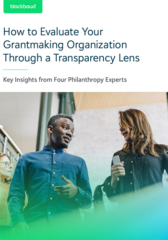The Core Elements of Empathy, Power, and Vulnerability in Grantmaking

We hear about Trust-Based Philanthropy and having a more grantee-centered approach to grantmaking. There was a surge in these perspectives and practices during COVID-19 when grantmakers understood even more strongly how nonprofits step up to support the community. Nonprofits needed more streamlined applications and processes to get resources out the door and trust from grantmakers that they could do more and better work with fewer limitations.
Even though these strategies were very successful, many of these efforts and energies have unfortunately reverted back to 2019 comfort zones and lost momentum. If that trust could be extended in uncertain circumstances, what does that say about the existing state of trust between grantees and grantors, in what I would argue are still very uncertain times?
There are three core elements that immediately come to mind when I think of trust: empathy, power, and vulnerability. These are core elements of trust and of any good relationship. When these values are activated to action, both parties thrive. What they can accomplish together is greater than what they can achieve alone, and their experience is richer and more fulfilling. If we know that the social impact sector can thrive with flexibility and that trust is ideal, why do we still fall short?
Empathy
I have had the honor of being both a grant researcher/writer/steward and a re-grantor. I have felt the frustration of completing horribly constructed online grant applications and experienced the exhilaration of being awarded significant funds. I’ve, thankfully, also felt the frustration of being limited in the available amounts and bureaucratic processes to deploy funds and relished in witnessing amazing impact within the community.
I often wonder what proportion of the folks working in philanthropy have had the privilege of also working in a nonprofit, and vice versa. For those social impact professionals who haven’t lived both lives, the empathy divide is real and must be overcome. When I was a grant writer, my favorite people to connect with inside foundations were those staff who had previously worked in nonprofit organizations. They understood the daily life of “Nonprofitland,” they were more understanding, flexible, and reachable. As a re-grantor, my favorite experiences included deeply listening to and honoring the experiences of community organization leaders as they discussed obstacles and we co-created plans to overcome those challenges.
When we haven’t lived both lives, we can sometimes create and adopt narratives of how philanthropy and nonprofits work, and how the staff within them operate. When we work in separation and disconnection, empathy divides can become empathy canyons. One clue is when you find yourself thinking or saying what they (meaning the “other”) want, feel, or need, without being able to cite deep understanding and connection. How this can show up is in statements like, “foundation staff are out-of-touch, power-hungry people who care more about their salaries than really making change” or “nonprofit staff are those who couldn’t hack it in ‘real jobs’, and they are randomly piecing together programs without any real expertise.” The comments sound harsh but I’ve heard both uttered, repeatedly. These statements reveal truths, harm, frustration, and also highlight powerful opportunities for empathetic connection and understanding.
Instead of leaning on shortcuts like false narratives, assumptions, and our own biased inferences, we need to embrace curiosity to achieve connection and trust. We need to identify what we know and don’t know about each other and the work. What do you wish you better understood about foundations or non-profits? How do they function? What do they need right now, what hurdles do they face, what are their goals for the future?
Empathy is about opening yourself up to new perspectives and learning. It’s about accepting that multiple truths, even when they are in opposition or in tension with your own, can be true at the same time. It’s about making space for another person’s truth and experiences to sit beside your own. We all need to add more chairs to each of our proverbial tables to better understand the perspectives “across the divide” and how by seeing each other’s point of view can transform our relationships and impact.
Power
As you can see, I am quite an empathy cheerleader because I’ve seen empathy transform people, organizations, and entire initiatives, but I’m also an empathy realist. When nonprofit professionals read about empathy, they might have had thoughts like I did when I was trying to secure grant support (and that I often get asked by audiences when I talk about forming an empathetic connection to someone in philanthropy): “How can I create an empathetic connection when I can’t even get a foundation to answer my emails, take my calls, discuss their application process, listen to me share about my mission and program, provide advice and clarification, give feedback, let me develop a relationship with them to best steward their gift, or understand their shifting priorities?!”
I share all of this not just to rant about the black box that many foundations appear to be but to illustrate the reality that empathy is also deeply intertwined with power, both institutional and personal. There is a significant power divide between foundations and nonprofits, mostly around money but also resources like social networks and social capital. To express it in simple terms, foundations can appear to be—or actually choose to be—as reclusive, private, and removed as they want because there is no accountability to be accessible, transparent, and connected. Are there specific guidelines and checklists they must follow? Who will find them at fault? What would a penalty look like? Foundations have the resources and power to choose how they want to function, so it is an institutional choice to be empathetic and to share power.
At the individual level, it is a choice to acknowledge and understand how your lived experiences, positionalities, and biases impact how you show up to this work and choose to be empathetic. How you see the world and how the world sees you translates to the power you hold. What power do you have in the relationship between foundations and nonprofits? What power do you wield that may be holding you back from achieving trusted relationships? What power could you use to elevate connection and impact?
Power in social impact is severely lopsided and usually weighted in favor of foundations, corporations, wealthy families, and individual donors. What if we acknowledged these power dynamics and shared the truths that without nonprofit organizations, the services they provide, the staff they employ, and the revenues they generate, our communities, our economy, and all levels of government would be at risk of collapse? We work in ecosystems to create social change; it is time we recognized our symbiosis, interdependence, and how sharing power can elevate our missions.
Vulnerability
Empathetic connections can transform your relationships and outcomes. Deconstructing and sharing power are also essential to success. Another essential piece connected to both empathy and power is vulnerability. If you want to be more empathetic and interrogate power, you have to be vulnerable, because when you are vulnerable, in essence, you are learning.
In the social sector, we have no mechanisms for learning. We rely on habits for how we learn, we have few practices for how we share learning, and we are not rewarded for learning. In the sector, we are praised for urgently building, creating, and intervening, but there is a harmful misconception that learning occurs in a straight line or can be adequately confined in a strategic plan, theory of change, or grant application. Anyone can tell you that learning is far from straightforward and instead is winding, messy, and unpredictable. We have deprioritized, stigmatized, and punished learning with the ways that we enforce impossible standards of perfection. We are asked to state with 100% certainty that we can create and measure outcomes with a specific population within a specific time even though we all know that we are working with complex challenges and with people who live embedded in systems that are intertwined with oppression, harmful policies, and inadequate institutions.
These ridiculous expectations are lethal to vulnerability. We are shown that we must fit within a mold to compete for resources and to be taken seriously. We are shown that if we are “wrong” and if we fail to meet the outcomes we promised, we will be punished. What is essential to learning and openness to change is vulnerability. What would be possible if a grant application had some wiggle room? What if we could safely say, “hmmm, we thought it was this, but now we are learning something different?” What if this learning was received with appreciation and curiosity, not judgment or negative consequence? What would it mean if ecosystems of both foundations and nonprofits could come together to share what they are learning without fearing a loss of their competitive edge, privacy, or power?
Building a Shared Understanding
While empathy, power, and vulnerability are all part of trust, so is truth-telling. We need to be open to speaking the truth about what’s working and what’s not, and for whom. We need to speak the truth that we don’t know always know what will create the most impact. We need shared understanding of each other’s work, the goals and the struggles; we need shared power to connect and support in new ways, and we need to be vulnerable enough to admit that we are all still learning all the time and need the support and resources to do so. I know we all can choose to learn and use new problem-solving skills that teach and honor empathy, shared power, and vulnerability.
Join us for The Roles of Power and Empathy in Grantmaking: How You Can Transform Uncertainty into Greater Impact, a webinar to learn how you can apply new skills to improve your grantee experience, and elevate empathy, power sharing, and vulnerability in your individual practice and organization.
 Free Resource
Free Resource
Build Stronger Relationships
Evaluate your organization through a transparency lense with our free whitepaper


